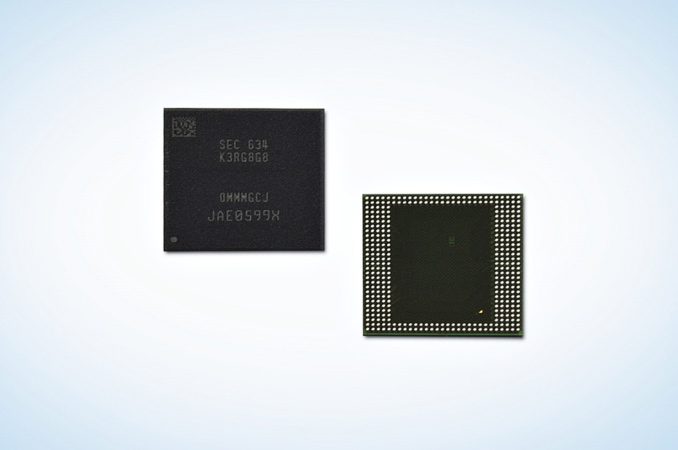Samsung Introduces 8 GB LPDDR4-4266 Package for Mobile Devices
by Anton Shilov on October 21, 2016 6:00 PM EST
Samsung this week announced its first LPDDR4 memory chips made using its 10nm-class DRAM fabrication technology. The new DRAM ICs feature the industry’s highest density of 16 Gb, are rated to run at 4266 MT/s data rate, and open the door to more mobile devices with 8 GB of DRAM.
Earlier this year Samsung started to produce DDR4 memory using its 10nm-class DRAM manufacturing process (which is believed to be 18 nm) and recently the firm began to use it to make LPDDR4 memory devices, just as it planned. The thinner fabrication technology allowed Samsung to increase capacity of a single LPDDR4 DRAM IC to 16 Gb (up from 12 Gb at 20nm introduced in August, 2015) while retaining a 4266 MT/s transfer rate.
The first product to use the 16 Gb ICs is Samsung’s 8 GB LPDDR4-4266 mobile DRAM package for smartphones, tablets, and other applications that can use LPDDR4. The device stacks four memory ICs and provides up to 34 GB/s of bandwidth when connected to an SoC using a 64-bit memory bus. The 8 GB DRAM package comes in a standard 15 mm x 15 mm x 1 mm form-factor, which is compatible with typical mobile devices, but Samsung can also make the package thinner than 1 mm to enable PoP stacking with a mobile application processor or a UFS NAND storage device.
| Samsung's 8 GB LPDDR4 DRAM Package | |||
| SEC 634 K3RG8G8 |
|||
| DRAM IC Capacity | 16 Gb | ||
| Number of DRAM ICs | 4 | ||
| Data Rate | 4266 MT/s | ||
| Bus Width | x64 | ||
| Bandwidth | 34 GB/s | ||
| Package | 15 mm x 15 mm x 1 mm | ||
| Process Technology | 10nm-class (18nm?) | ||
Samsung has not revealed a lot about the cost efficiency or power consumption of the 16 Gb LPDDR4 ICs, nor have they discussed those details for the 8 GB LPDDR4 package either. What little Samsung has said is that the latter consumes approximately the same amount of power as a 4 GB LPDDR4-3200 device (four 8 Gb ICs) made using its 20 nm-class process technology. Taken at face value, one can extrapolate that the switch to the 10nm-class fabrication process allowed Samsung to double the capacity and increase performance by 33% at the same power. Unfortunately, we do not know anything about the geometry scaling of the new ICs relative to Samsung's older ICs, so it's hard to even guess how much Samsung's newest DDR4 costs to fab.
Samsung has not officially commented on when it plans to start commercial shipments of its 8 GB LPDDR4 packages, but it is reasonable to assume that the company will commence sales of such devices in the coming months, with actual products hitting the market in 2017.
Source: Samsung










40 Comments
View All Comments
psychobriggsy - Saturday, October 22, 2016 - link
Because the signal lengths from memory controller to memory are so much shorter for LPDDR4.Standard DDR has to go several cm over a motherboard, and through a connector.
yuhong - Sunday, October 23, 2016 - link
And 2 unbuffered DIMMs per channel only makes it worse. I wonder if that will die off for anything other than Xeons, especially after 16Gbit DDR4 comes out.yuhong - Friday, October 21, 2016 - link
I think they are doing 16Gbit LPDDR4 instead of DDR4 this time because that can tolerate large die sizes better, right?Michael Bay - Friday, October 21, 2016 - link
Which raises the question, why would I need such gargantian amounts of RAM in my phone, if all I do is call, SMS and maybe browse a bit. Is VR a good driver for those crazy capacities? Isn`t GPU a bottleneck right now?keeepcool - Friday, October 21, 2016 - link
Maybe KabyLake can talk to LPDDR4 and 16Gb single chip would be sweet for ultra thin laptops/whatever they call them this month.Maybe we will see them in the rumored new Macs?
They where rumored to have LPDDR4 support and LPDDR3 is official, so a special flavour cpu for Apple would not surprise me.
Michael Bay - Friday, October 21, 2016 - link
You`re probably right. I got "mobile devices" and phones conflated.extide - Sunday, October 23, 2016 - link
16Gb is only 2GB so .. you would still need a few.Rocket321 - Monday, October 24, 2016 - link
They can be stacked 4 high, giving 8GB in the area of one die.stephenbrooks - Friday, October 21, 2016 - link
The cheap phones have a tendency to have rather slow storage cards, so the more apps and data you can load into RAM, the faster it'll be. You can end up with it working basically off of RAM but with the storage card mirroring it.ZeDestructor - Friday, October 21, 2016 - link
So I can have more things in background that aren't killed (like my password manager).. For some reason, my phone usage still hits RAM cap with a 4GB phone, and that's still not an improvement over my 3GB phone :/